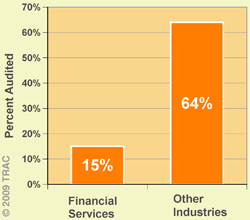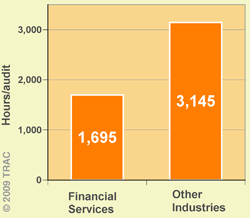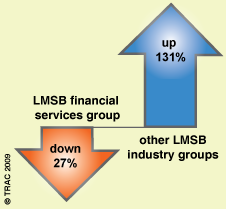
Figure 1. Audit Rates of Large Corporations (Assets $250 Million or More) by Industry Sector |
The regulation of corporate America is the responsibility of many different federal agencies. The Securities and Exchange Commission, for one example, is directly responsible for regulating brokerage houses, investment advisors and certain others in the financial services sector of the economy.
But the ability of this specialized body and others like it to enforce the rules relies in part on the broad expectation that the books of the regulated companies will be on the up and up, a hope that is reinforced by the day-in-and-day-out work of the much larger army of 13,000 IRS revenue agents who have responsibility for auditing the financial records of all businesses.
And at a time of growing budget deficits, making sure that all businesses accurately report the taxes they owe is of increasing importance.
Thus the unannounced decision of the IRS more than five years ago to place a much lower priority on examining large and mid-size financial services companies than it was devoting to the financial records of other business sectors may have undermined the ability of the specialized regulatory agencies to identify and deal with the questionable activities of some of these companies as the American economy slipped into a serious recession. The question: did the decision of the IRS to cut back on its financial services audits in a direct or indirect way contribute to the failure of the government to uncover the criminal schemes of Bernard L. Madoff and others like him in a timely manner?
This is the second in a two-part series of TRAC reports based on IRS information obtained under the FOIA, including a series of court orders requiring the release of hundreds of thousands of pages of internal IRS reports. In the previous report, TRAC documented how in FY 2008 the IRS only allocated 15% of its available revenue agents to the special group within the organization which had the lead authority for examining large and mid-size financial services businesses. This occurred even though these auditors consistently uncovered higher levels of tax underreporing in that area than was noted in other groups.
That report also provided information showing that even as the agency was deciding to focus only a small part of its expert workforce on these businesses, the financial sector had developed into a more and more important part of the overall economy. In the just ended fiscal year, for example, this one sector accounted for three quarters of the tax returns of the largest corporations and 72% of all large-corporation assets.
Latest Data Support Earlier Findings
|
Table 1. Audit Rates of
Largest Corporations,* FY 2008
| |||||||||||||||
But completely new data — only provided TRAC late on Friday, April 3 — show in concrete terms how the IRS's disproportionate staffing decisions affected the agency's actual audit rates for the financial services corporations. Last year, looking at the largest corporations with assets of $250 million or more, nearly two out of every three returns (64%) filed by large corporations outside of the financial services sector were audited by the IRS. In contrast, for the more than 10,000 of large financial services companies, only 15% of them were audited in FY 2008 (see Figure 1 and Table 1). As TRAC documented in a 2005 report, the problem is not new. Thus, unlike the situation for the rest of large corporate America, the IRS in recent years has not regularly examined the returns of the large financial services companies.
Less Time Devoted to Financial Service Audits

Figure 2. Average Hours Per Audit For Corporations with Assets of $20 Billion or More by Industry Sector |
But the new data show that the contrasts don't end there. When a financial services firm was audited, the thoroughness of the audit — measured by the average hours the auditor spent — also was very different. For example, focusing only on the largest companies audited — those with $20 billion or more in assets — the audit for companies not in the financial sector averaged 3,145 hours of direct examiner time. Despite the unique challenge of understanding derivatives and the like, however, the audits for financial services giants averaged 1,695 hours, about half the time the typical audit took for all behemoths (see Figure 2). This was not simply an anomaly; as shown in Table 2 the identical pattern was found for all of the other categories of large corporations.
|
Table 2. Average Hours per Audit, FY 2008
|

Figure 3. Number of Audits for Large Financial Services Corporations (Assets $250 Million or More) by Large and Mid-size Business Division Auditor Groups |
Fewer Financial Service Audits Performed by FS Specialists
Because of the shrinking resources IRS was giving to the auditors in its Financial Services group, there has been a dramatic shift in which industry group is conducting audits of financial services firms. During FY 2004, the Financial Services group conducted most of the audits of the large financial services companies (see Table 3). But during the last five years the actual number of such audits declined by 27%. In contrast, over the same five year period, the audits completed of large financial companies by the four other nonfinancial industry groups more than doubled, up by 131% (see Figure 3). The end result: the group that is currently charged with the responsibility for policing the financial services sector is today not conducting the majority of audits of large financial services corporations. This was true even for the largest of the large corporations, those with assets of $20 billion or more.
|
Table 3. Audits of Largest Financial Services Corporations
by Large and Mid-Size Business Division Auditor Group*
| ||||||||||||||||||||||||||